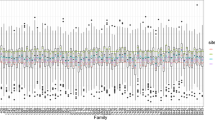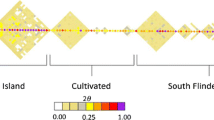Abstract
Development of selection methods that optimises selection differential subject to a constraint on the increase of inbreeding (or coancestry) in a population is an important part of breeding programmes. One such method that has received much attention in animal breeding is the optimum contribution (OC) dynamic selection method. We implemented the OC algorithm and applied it to a diallel progeny trial of Pinus sylvestris L. (Scots pine) focussing on two traits (total tree height and stem diameter). The OC method resulted in a higher increase in genetic gain (8–30%) compared to the genetic gain achieved using standard restricted selection method at the same level of coancestry constraint. Genetic merit obtained at two different levels of restriction on coancestry showed that the benefit of OC was highest when restriction was strict. At the same level of genetic merit, OC decreased coancestry with 56 and 39% for diameter and height, respectively, compared to the level of coancestry obtained using unrestricted truncation selection. Inclusion of a dominance term in the statistical model resulted in changes in contribution rank of trees with 7 and 13% for diameter and height, respectively, compared to results achieved by using a pure additive model. However, the genetic gain was higher for the pure additive model than for the model including dominance for both traits.



Similar content being viewed by others
References
Andersson EW, Sánchez L, Andersson B (1999) Group coancestry-controlled selection in a Pinus sylvestris L. breeding program. Theor Appl Genet 99:73–80
Avendaño S, Villanueva B, Woolliams JA (2003) Expected increases in genetic merit from using optimized contributions in two livestock populations of beef cattle and sheep. J Anim Sci 81:2964–2975
Avendaño S, Woolliams JA, Villanueva B (2004) Mendelian sampling terms as a selective advantage in optimum breeding schemes with restriction on the rate of inbreeding. Genet Res 83:55–64
Fernandez J, Toro MA (1999) The use of mathematical programming to control inbreeding in selection schemes. J Anim Breed Genet 116:447–466
Fernandez J, Toro MA (2001) Controlling genetic variability by mathematical programming in a selection scheme on an open-pollinated population in Eucalyptus globulus. Theor Appl Genet 102:1056–1064
Gianola D (2001) Inferences about breeding values. In: Balding DJ, Bishop M, Cannings C (eds) Handbook of statistical genetics. Wiley, Buffins Lane, pp 645–672
Gilmour AR, Gogel BJ, Cullis BR, Thompson R (2006) ASReml User Guide Release 2.0 VSN International Ltd. Hemel Hempstead
Grundy B, Villanueva B, Woolliams JA (1998) Dynamic selection procedures for constrained inbreeding and their consequences for pedigree development. Genet Res 72:159–168
Hannrup B, Jansson G, Danell O (2007) Comparing gain and optimum test size from progeny testing and phenotypic selection in Pinus sylvestris. Can J For Res 37:1227–1235
Henderson CR (1985) Best linear unbiased prediction of nonadditive genetic merits in noninbred populations. J Anim Sci 60:111–117
Henderson CR, Quaas RL (1976) Multiple trait evaluation using relatives’ records. J Anim Sci 43:1188–1197
Hinrichs D, Wetten M, Meuwissen THE (2006) An algorithm to compute optimal genetic contributions in selection programs with large numbers of candidates. J Anim Sci 84:3212–3218
Kearney JF, Wall E, Villanueva B, Coffey MP (2004) Inbreeding trends and application of optimized selection in the UK Holstein population. J Dairy Sci 87:3503–3509
Kerr RJ, Goddard ME, Jarvis SF (1998) Maximising genetic response in tree breeding with constraints on group coancestry. Silvae Genet 47:165–173
Lindgren D, Mullin TJ (1997) Balancing gain and relatedness in selection. Silvae Genet 46:124–129
Lindgren D, Gea LD, Jefferson PA (1996) Loss of genetic diversity monitored by status number. Silvae Genet 45:52–59
Lstiburek M, Mullin TJ, Mackay TFC, Huber D, Li B (2005) Positive assortative mating with family size as a function of predicted parental breeding values. Genetics 171:1311–1320
Lynch M, Walsh B (1998) Genetics and analysis of quantitative traits. Sinauer Assoc, Sunderland
Meuwissen THE (1997) Maximizing the response of selection with a predefined rate of inbreeding. J Anim Sci 75:934–940
Misztal I (1997) Estimation of variance components with large-scale dominance models. J Dairy Sci 80:965–974
Olsson T, Lindgren D, Ericsson T (2000) A comparison of group merit selection and restricted selection among full-sib progenies of Scots pine. For Genet 7:137–144
Pante MJR, Gjerde B, McMillan I, Misztal I (2002) Estimation of additive and dominance genetic variances for body weight at harvest in rainbow trout, Oncorhynchus mykiss. Aquaculture 204:383–392
Robertson A (1961) Inbreeding in artificial selection programs. Genet Res 2:189–194
Rosvall O, Mullin TJ, Lindgren D (2003) Controlling parent contributions during positive assortative mating and selection increases gain in long-term forest tree breeding. For Genet 10:35–53
Ruotsalainen S, Lindgren D (2001) Number of founders for a breeding population using variable parental contribution. For Genet 8:57–67
Sánchez L (2000) Balanced verus slightly unbalanced selection. Heredity 84:685–691
Schneeberger M, Barwick SA, Crow GH, Hammond K (1992) Economic indices using breeding values predicted by BLUP. J Anim Breed Genet 109:180–187
Serenius T, Stalder KJ, Pounti M (2006) Impact of dominance effects on sow longevity. J Anim Breed Genet 123:355–361
Stoehr M, Yanchuk A, Xie C-Y, Sánchez L (2007) Gain and diversity in advanced generation coastal Douglas-fir selections for seed production populations. Tree Genet Genomes 4:193–200
Toro M, Pérez-Enciso M (1990) Optimization of selection response under restricted inbreeding. Genet Sel Evol 22:93–107
Vaida F, Blanchard S (2005) Conditional Akaike information for mixed-effects models. Biometrika 92:351–370
Waldmann P, Ericsson T (2006) Comparison of REML and Gibbs sampling estimates of multi-trait breeding values in Scots pine. Theor Appl Genet 112:1441–1451
Waldmann P, Hallander J, Hoti F, Sillanpää MJ (2008) Efficient MCMC implementation of Bayesian analysis of additive and dominance genetic variances in non-inbred pedigrees. Genetics 179:1101–1112
Wall E, Brotherstone S, Kearney JF, Woolliams JA, Coffey MP (2005) Impact of nonadditive genetic effects in the estimation of breeding values for fertility and correlated traits. J Dairy Sci 88:376–385
Wei RP, Lindgren D (2006) Stepwise penalty index selection from populations with a hierarchical structure. Silvae Genet 55:62–70
Wilhelmsson L, Andersson B (1993) Breeding programs in Sweden-Scots pine and Lodgepole pine. 1 Progeny testing and breeding strategies. In: Lee SJ (ed) Proceedings of the Nordic group for tree breeding. Edinburgh, Scotland, pp 135–145
Woolliams JA (2007) Genetic contributions and inbreeding. In: Oldenbroek K (ed) Utilisation and conservation of farm animal genetic resources. Wageningen Academic Publisher, Netherlands, pp 147–165
Zheng YQ, Lindgren D, Rosvall O, Westin J (1997) Combining genetic gain and diversity by considering average coancestry in clonal selection of Norway spruce. Theor Appl Genet 95:1312–1319
Acknowledgments
Financial support was provided by the Research School in Forest Genetics and Breeding at the Swedish University of Agricultural Sciences (SLU). The Scots pine data was provided by the The Forestry Research Institute of Sweden, Skogforsk. We would like to acknowledge the associate editor and three anonymous reviewers for comments that improved the paper. In addition, we would also like to thank Chunkao Wang, Johan Kroon, Mats Berlin and Bengt Andersson for helpful discussions.
Author information
Authors and Affiliations
Corresponding author
Additional information
Communicated by M. Sillanpää.
Rights and permissions
About this article
Cite this article
Hallander, J., Waldmann, P. Optimum contribution selection in large general tree breeding populations with an application to Scots pine. Theor Appl Genet 118, 1133–1142 (2009). https://doi.org/10.1007/s00122-009-0968-7
Received:
Accepted:
Published:
Issue Date:
DOI: https://doi.org/10.1007/s00122-009-0968-7




